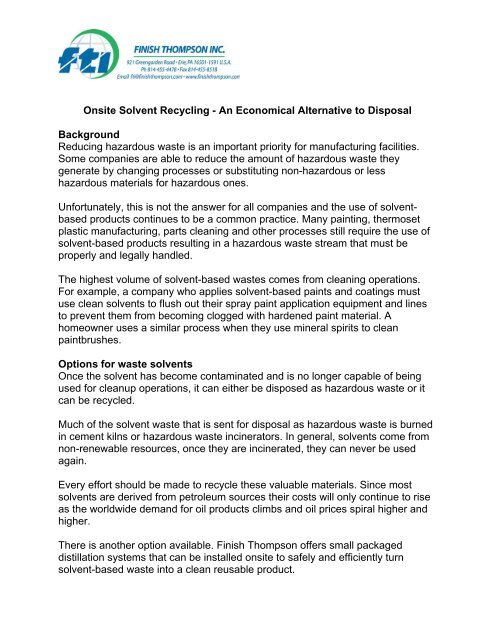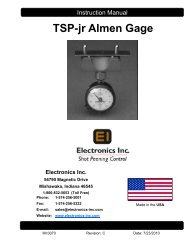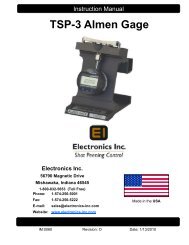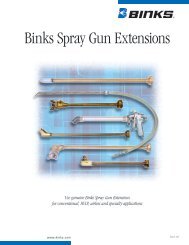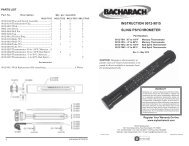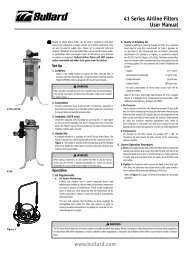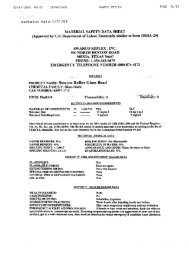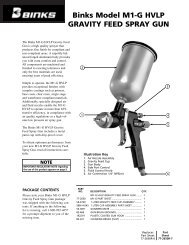Onsite Solvent Recycling - Finish Thompson Inc.
Onsite Solvent Recycling - Finish Thompson Inc.
Onsite Solvent Recycling - Finish Thompson Inc.
- No tags were found...
Create successful ePaper yourself
Turn your PDF publications into a flip-book with our unique Google optimized e-Paper software.
<strong>Onsite</strong> <strong>Solvent</strong> <strong>Recycling</strong> - An Economical Alternative to Disposal<br />
Background<br />
Reducing hazardous waste is an important priority for manufacturing facilities.<br />
Some companies are able to reduce the amount of hazardous waste they<br />
generate by changing processes or substituting non-hazardous or less<br />
hazardous materials for hazardous ones.<br />
Unfortunately, this is not the answer for all companies and the use of solventbased<br />
products continues to be a common practice. Many painting, thermoset<br />
plastic manufacturing, parts cleaning and other processes still require the use of<br />
solvent-based products resulting in a hazardous waste stream that must be<br />
properly and legally handled.<br />
The highest volume of solvent-based wastes comes from cleaning operations.<br />
For example, a company who applies solvent-based paints and coatings must<br />
use clean solvents to flush out their spray paint application equipment and lines<br />
to prevent them from becoming clogged with hardened paint material. A<br />
homeowner uses a similar process when they use mineral spirits to clean<br />
paintbrushes.<br />
Options for waste solvents<br />
Once the solvent has become contaminated and is no longer capable of being<br />
used for cleanup operations, it can either be disposed as hazardous waste or it<br />
can be recycled.<br />
Much of the solvent waste that is sent for disposal as hazardous waste is burned<br />
in cement kilns or hazardous waste incinerators. In general, solvents come from<br />
non-renewable resources, once they are incinerated, they can never be used<br />
again.<br />
Every effort should be made to recycle these valuable materials. Since most<br />
solvents are derived from petroleum sources their costs will only continue to rise<br />
as the worldwide demand for oil products climbs and oil prices spiral higher and<br />
higher.<br />
There is another option available. <strong>Finish</strong> <strong>Thompson</strong> offers small packaged<br />
distillation systems that can be installed onsite to safely and efficiently turn<br />
solvent-based waste into a clean reusable product.
<strong>Onsite</strong> recycling<br />
Many processes used to recycle other waste streams like reverse osmosis or ion<br />
exchange do not work for recycling solvent waste streams. The contaminants<br />
would quickly foul the membranes and resin beds. The one method with a proven<br />
track record is distillation.<br />
Available since the early 80’s, thousands of these onsite distillation systems are<br />
being successfully used to recycle millions of gallons of waste solvent each year<br />
resulting in tremendous financial savings.<br />
In addition to the monetary savings, onsite recycling reduces the amount of<br />
waste solvents leaving the facility by 85% to 95%, helps save a dwindling<br />
resource and reduces the emissions of the greenhouse gas carbon dioxide<br />
(generated when the solvent waste is burned in cement kilns and incinerators).<br />
It is amazing how much clean solvent is available in the typical solvent waste<br />
stream. Most waste solvent has only 5% to 10% contaminates (paint, resins, ink,<br />
grease, oil, etc). The remaining solvent is available for recovery and reuse.<br />
Distillation process<br />
Distillation is the process of purifying a liquid by evaporation and condensation.<br />
Simply, distillation is the process in which a liquid is vaporized (turned to steam),<br />
condensed (turned back into a liquid) and the clean liquid is collected in a<br />
container. Nature uses a process similar to distillation to turn salt water<br />
(seawater) into fresh water (rain) through evaporation and condensation.<br />
<strong>Solvent</strong>-based waste contains volatile material (solvents) and non-volatile<br />
material (contaminants like paint, ink, grease, fiberglass, etc.). Many of the nonvolatile<br />
contaminates are dissolved in the solvent (like salt dissolved in salt<br />
water) and cannot be filtered out. Distillation is an ideal way to separate the two.<br />
During the distillation process, the solvent-based waste is heated until it reaches<br />
the boiling point. It then evaporates (vaporizes) and passes through a condenser<br />
where heat is removed from the vapor and it turns back into a cool, clean<br />
reusable liquid. The non-volatile contaminant remains in the distillation tank and<br />
is easily removed for disposal.<br />
The standard distillation system operates at atmospheric pressure and is used to<br />
recover solvents with boiling points up to 300º F. To safely recover solvents with<br />
boiling points above 300º F, vacuum distillation is used.<br />
Vacuum distillation<br />
Vacuum distillation is the distillation of a liquid under reduced pressure. The<br />
atmospheric pressure in the distillation tank is reduced making it possible to boil<br />
the liquid at a lower temperature. Liquids boil at lower temperatures under<br />
reduced pressure.
Vacuum distillation is used to safely recover higher boiling point solvents. The<br />
maximum temperature of the distillation unit’s heater is limited for safety. There is<br />
a temperature at which a flammable or combustible material can ignite by<br />
temperature only. This is called the autoignition temperature. Some solvents boil<br />
at temperatures that exceed the heaters maximum temperature setting. Vacuum<br />
distillation lowers the boiling point to allow recovery within the heaters maximum<br />
setting.<br />
Economics<br />
New solvent can easily cost $8.00 per gallon or more. Many companies choose<br />
to purchase new solvent, use it in their cleaning operations and then dispose of it<br />
as hazardous waste. This cycle is repeated over and over throughout the year.<br />
The installation of a <strong>Finish</strong> <strong>Thompson</strong> onsite solvent distillation system can<br />
recycle the waste solvent for as low as ten cents per gallon. Imagine paying only<br />
ten cents for a gallon of clean solvent!<br />
An LS-55E is a good example for a cost evaluation though the results are<br />
essentially the same for any of the sizes. The LS-55E processes 55-gallons of<br />
waste solvent per batch. The typical batch takes between 6 and 8 hours.<br />
The LS-55E has a 6.2 kW heating element and uses 90 gallons of cooling water<br />
per hour (there are options available which eliminate the cooling water<br />
requirement). This example uses utility rates of $0.07 per kWh and $0.003 per<br />
gallon of water. It can be adjusted up or down depending upon individual rates<br />
but in all cases there are significant savings.<br />
• Electrical usage per 55-gallon batch = $0.07 (cost per kWh) x 6.2 kW<br />
(heater wattage) x 8 (hours to process a 55-gallon batch) = $3.47 of<br />
electricity per 55-gallon batch<br />
• Water usage per 55-gallon batch = $0.003 (cost per gallon of water) x 90<br />
(gallons of water used per hour) x 8 (hours to process a 55-gallon batch) =<br />
$2.16 of water per 55-gallon batch<br />
• $3.47 (cost of electricity) + $2.16 (cost of water) = $5.63 total utility cost<br />
per 55-gallon batch<br />
• $5.63 ÷ 55 gallon batch = $0.10 per gallon of solvent<br />
It is obvious there is a tremendous savings when waste solvent is recycled<br />
onsite.<br />
Equipment features<br />
<strong>Finish</strong> <strong>Thompson</strong>’s LS Series solvent recyclers are the ideal solution for<br />
companies with solvent-based waste streams. Designed to provide years of safe,
simple and reliable operation the equipment returns a nearly pure, completely<br />
reusable solvent at a very low cost per gallon.<br />
Manufacturing explosion proof solvent recycling systems for over thirty years,<br />
<strong>Finish</strong> <strong>Thompson</strong> systems are suitable for recovering a wide variety of solvents<br />
including ones that are flammable or combustible.<br />
<strong>Inc</strong>orporating many unique features, they are designed to be user friendly.<br />
The encapsulated heating element eliminates the need for heat transfer oil. This<br />
improves heat transfer, lowers energy usage and makes it maintenance free.<br />
The waste solvent is processed in a special solvent resistant, high-temperature<br />
bag that makes residue removal as easy as pulling a garbage bag out of a<br />
garbage can. The distillation tank is coated with an industrial grade, non-stick<br />
coating in case there are any spills.<br />
Several versions are available to handle the needs of a wide variety of<br />
applications and volumes.<br />
To learn more about how your company can save thousands of dollars per year<br />
while being environmentally responsible contact us at 814-455-4478 or visit our<br />
website at www.finishthompson.com


